1997 SSANGYONG KORANDO check engine
[x] Cancel search: check enginePage 1516 of 2053
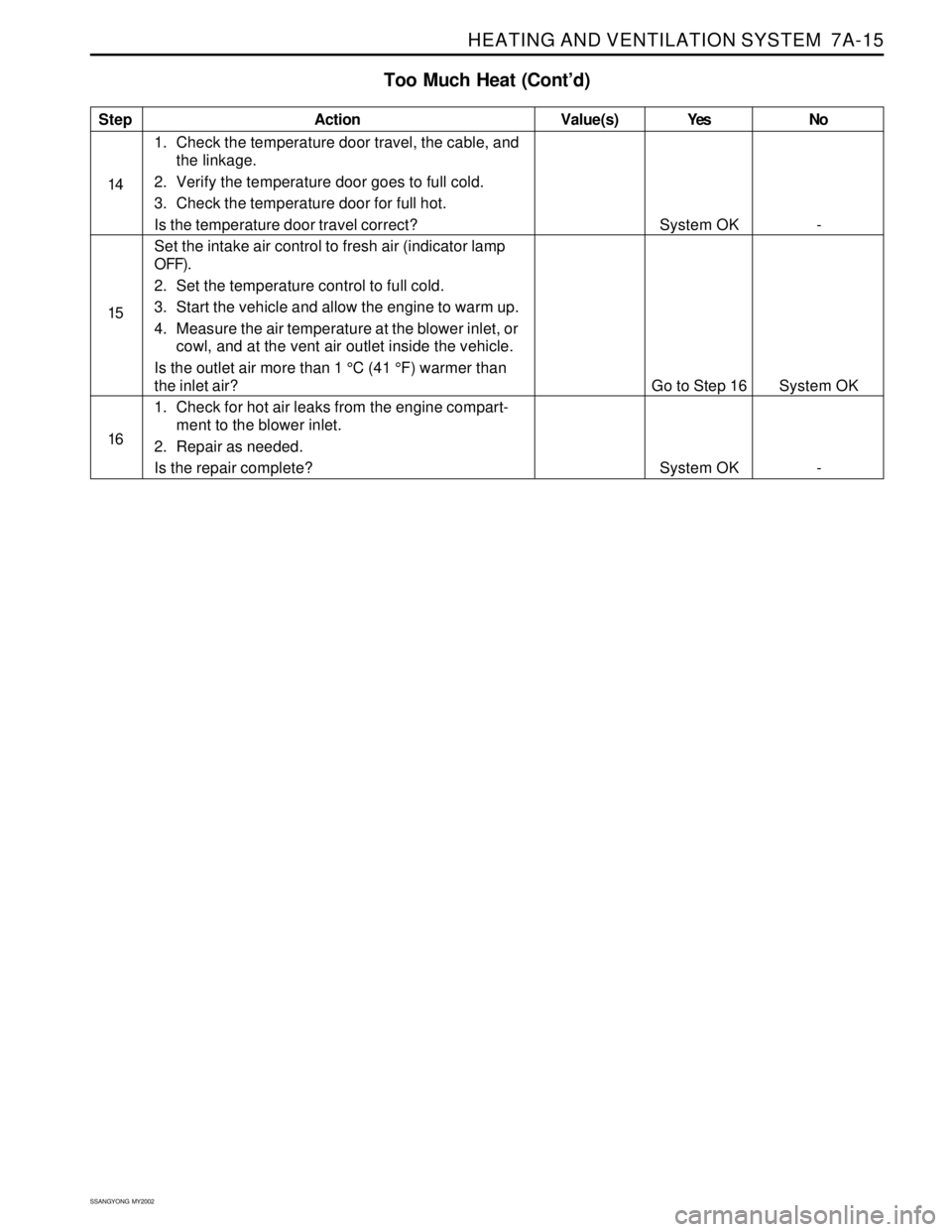
HEATING AND VENTILATION SYSTEM 7A-15
SSANGYONG MY2002
Too Much Heat (Cont’d)
Step
14
15
16Action
1. Check the temperature door travel, the cable, and
the linkage.
2. Verify the temperature door goes to full cold.
3. Check the temperature door for full hot.
Is the temperature door travel correct?
Set the intake air control to fresh air (indicator lamp
OFF).
2. Set the temperature control to full cold.
3. Start the vehicle and allow the engine to warm up.
4. Measure the air temperature at the blower inlet, or
cowl, and at the vent air outlet inside the vehicle.
Is the outlet air more than 1 °C (41 °F) warmer than
the inlet air?
1. Check for hot air leaks from the engine compart-
ment to the blower inlet.
2. Repair as needed.
Is the repair complete?Yes
System OK
Go to Step 16
System OKNo
-
System OK
-Value(s)
Page 1517 of 2053

SSANGYONG MY2002
7A-16 HEATING AND VENTILATION SYSTEM
BLOWER NOISE
Step
1
2
3
4
5
6
7
8
9
10
11
12
13
14Action
Verify the customer’s complaint.
Are the customer’s concerns verified?
1. Sit inside the vehicle.
2. Close the doors and windows.
3. Turn the ignition ON.
4. Start the engine.
5. Set the temperature to full cold.
6. Cycle through the blower speeds, the modes, and
the temperature settings in order to find the noise.
Is the blower noise constant at high blower speeds or
in other modes?
Check for vibrations from the blower motor and fan
assembly at each blower speed by feeling the blower
motor housing.
Did you find excessive vibration?
1. Remove the blower motor and fan assembly.
Refer to “Blower Motor” in this section.
2. Check for foreign materials at the opening of the
blower inlet.
Did you find any foreign materials at the blower inlet?
Remove all foreign materials.
Is the repair complete?
1. Examine the blower fan for wear spots, cracked
blades, a cracked hub, a loose fan retaining nuts,
or bad alignment.
2. Examine the blower case for sports.
Did you find any problem?
Repair as required.
Is the repair complete?
Replace the motor and fan assembly.
Is the repair complete?
If the noise is a click/tick or whine, replace the motor.
Is the repair complete?
Reinstall the original motor.
Is the problem still present?
1. Set the blower speed on 4.
2. Check full hot to full cold temperature positions in
the defroster, floor, and vent modes.
Is the noise present in the defrost mode only?
1. Check the ducts for obstructions for foreign
materials.
2. Remove any obstructions or foreign materials.
3. Check floor /defroster door seals.
4. Repair or replace as needed.
Is the repair complete?
Is the noise present in the floor mode only?
Is the noise present in the vent mode only?Yes
Go to Step 2
Go to Step 11
Go to Step 6
Go to Step 5
System OK
Go to Step 7
System OK
System OK
System OK
Go to Step 11
Go to Step 12
System OK
Go to Step 12
Go to Step 15No
System OK
Go to Step 3
Go to Step 4
Go to Step 6
Go to Step 6
Go to Step 9
Go to Step 8
Go to Step 9
Go to Step 10
System OK
Go to Step 14
-
Go to Step 14
Go to Step 16Value(s)
-
Page 1536 of 2053
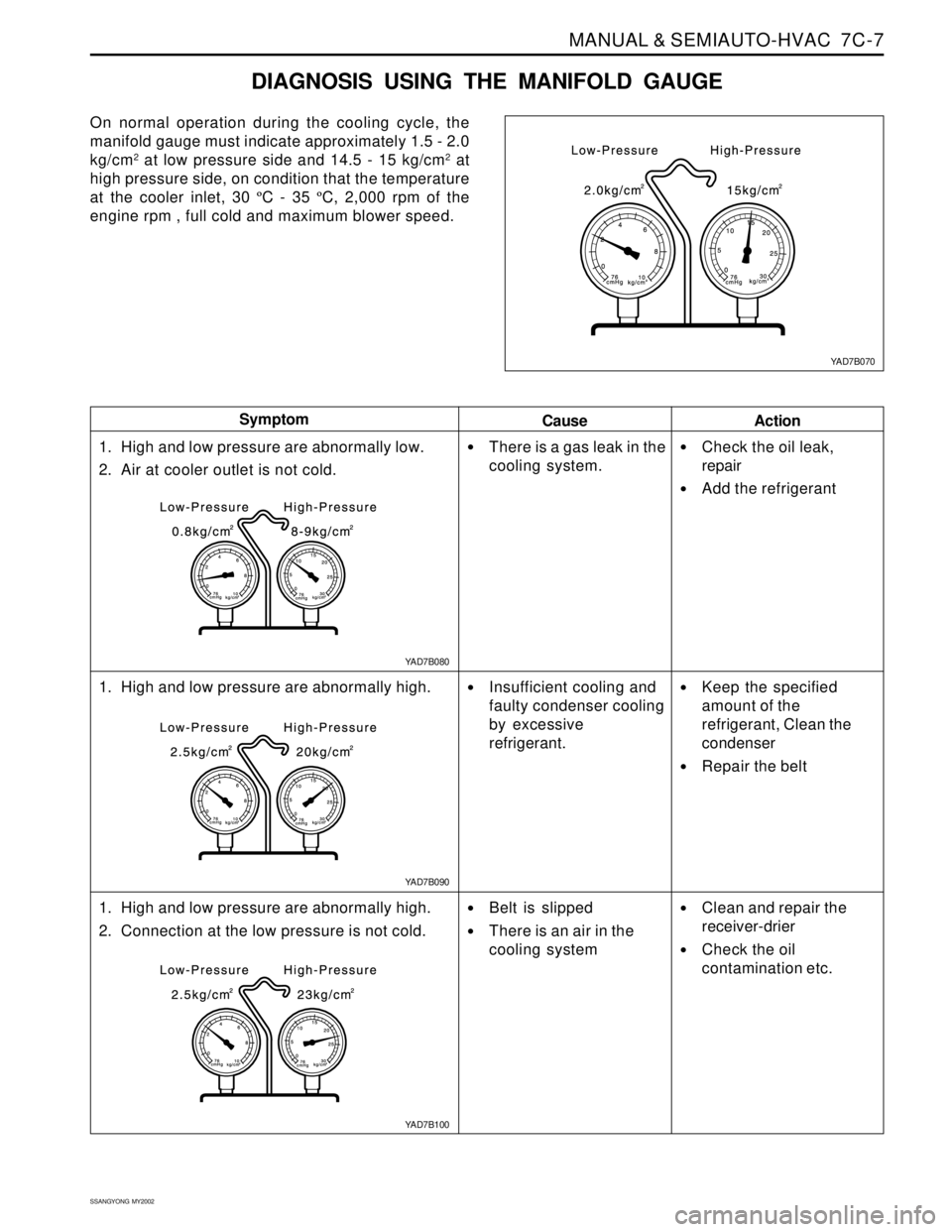
MANUAL & SEMIAUTO-HVAC 7C-7
SSANGYONG MY2002
DIAGNOSIS USING THE MANIFOLD GAUGE
On normal operation during the cooling cycle, the
manifold gauge must indicate approximately 1.5 - 2.0
kg/cm
2 at low pressure side and 14.5 - 15 kg/cm2 at
high pressure side, on condition that the temperature
at the cooler inlet, 30 ºC - 35 ºC, 2,000 rpm of the
engine rpm , full cold and maximum blower speed.
Cause Symptom
Action
1. High and low pressure are abnormally low.
2. Air at cooler outlet is not cold.
1. High and low pressure are abnormally high.
1. High and low pressure are abnormally high.
2. Connection at the low pressure is not cold.
There is a gas leak in the
cooling system.
Insufficient cooling and
faulty condenser cooling
by excessive
refrigerant.
Belt is slipped
There is an air in the
cooling system
Check the oil leak,
repair
Add the refrigerant
Keep the specified
amount of the
refrigerant, Clean the
condenser
Repair the belt
Clean and repair the
receiver-drier
Check the oil
contamination etc.
YAD7B070
YAD7B080
YAD7B100 YAD7B090
Page 1546 of 2053
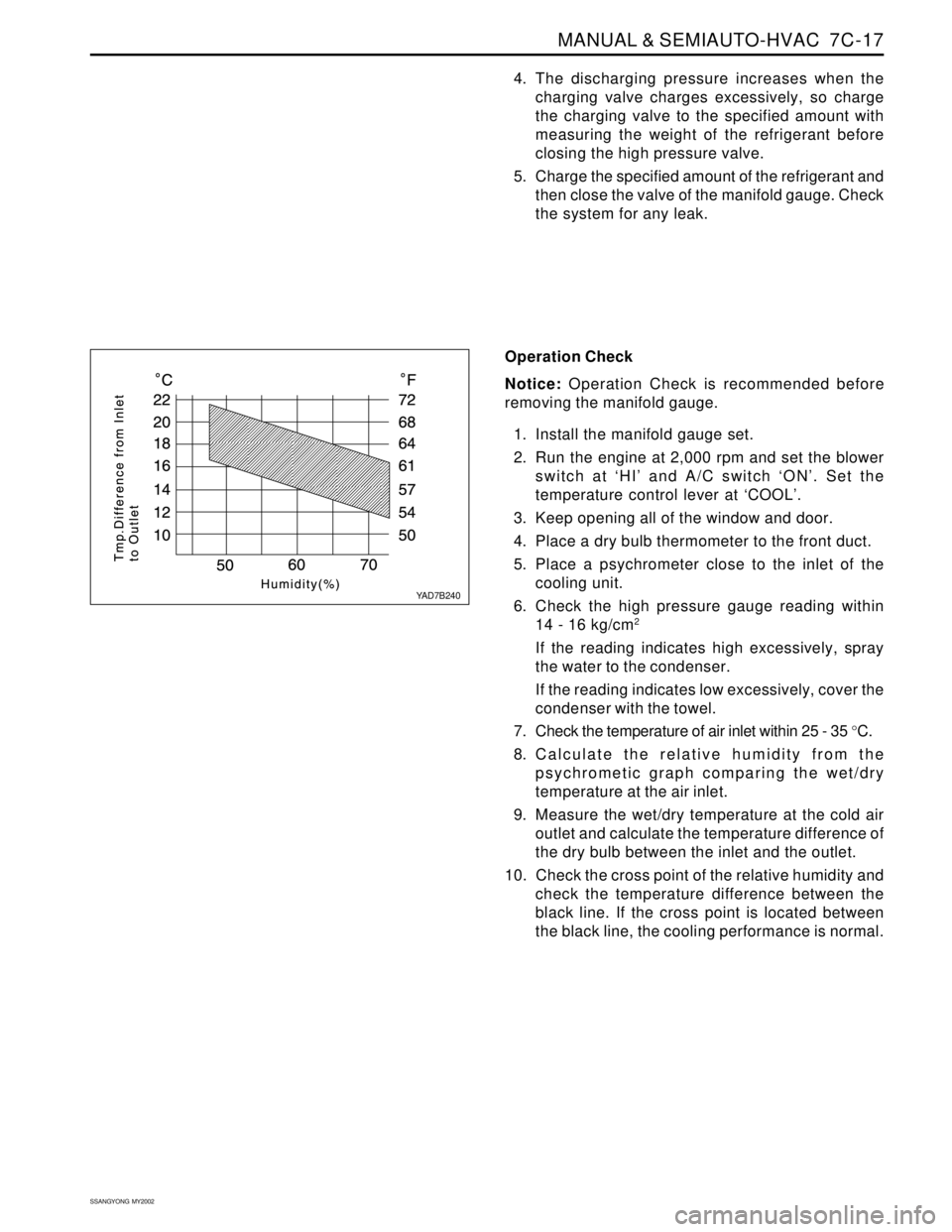
MANUAL & SEMIAUTO-HVAC 7C-17
SSANGYONG MY2002
����� �����
�����
Operation Check
Notice: Operation Check is recommended before
removing the manifold gauge.
1. Install the manifold gauge set.
2. Run the engine at 2,000 rpm and set the blower
switch at ‘HI’ and A/C switch ‘ON’. Set the
temperature control lever at ‘COOL’.
3. Keep opening all of the window and door.
4. Place a dry bulb thermometer to the front duct.
5. Place a psychrometer close to the inlet of the
cooling unit.
6. Check the high pressure gauge reading within
14 - 16 kg/cm
2
If the reading indicates high excessively, spray
the water to the condenser.
If the reading indicates low excessively, cover the
condenser with the towel.
7. Check the temperature of air inlet within 25 - 35 °C.
8. Calculate the relative humidity from the
psychrometic graph comparing the wet/dry
temperature at the air inlet.
9. Measure the wet/dry temperature at the cold air
outlet and calculate the temperature difference of
the dry bulb between the inlet and the outlet.
10. Check the cross point of the relative humidity and
check the temperature difference between the
black line. If the cross point is located between
the black line, the cooling performance is normal.
4. The discharging pressure increases when the
charging valve charges excessively, so charge
the charging valve to the specified amount with
measuring the weight of the refrigerant before
closing the high pressure valve.
5. Charge the specified amount of the refrigerant and
then close the valve of the manifold gauge. Check
the system for any leak.
YAD7B240
Page 1547 of 2053
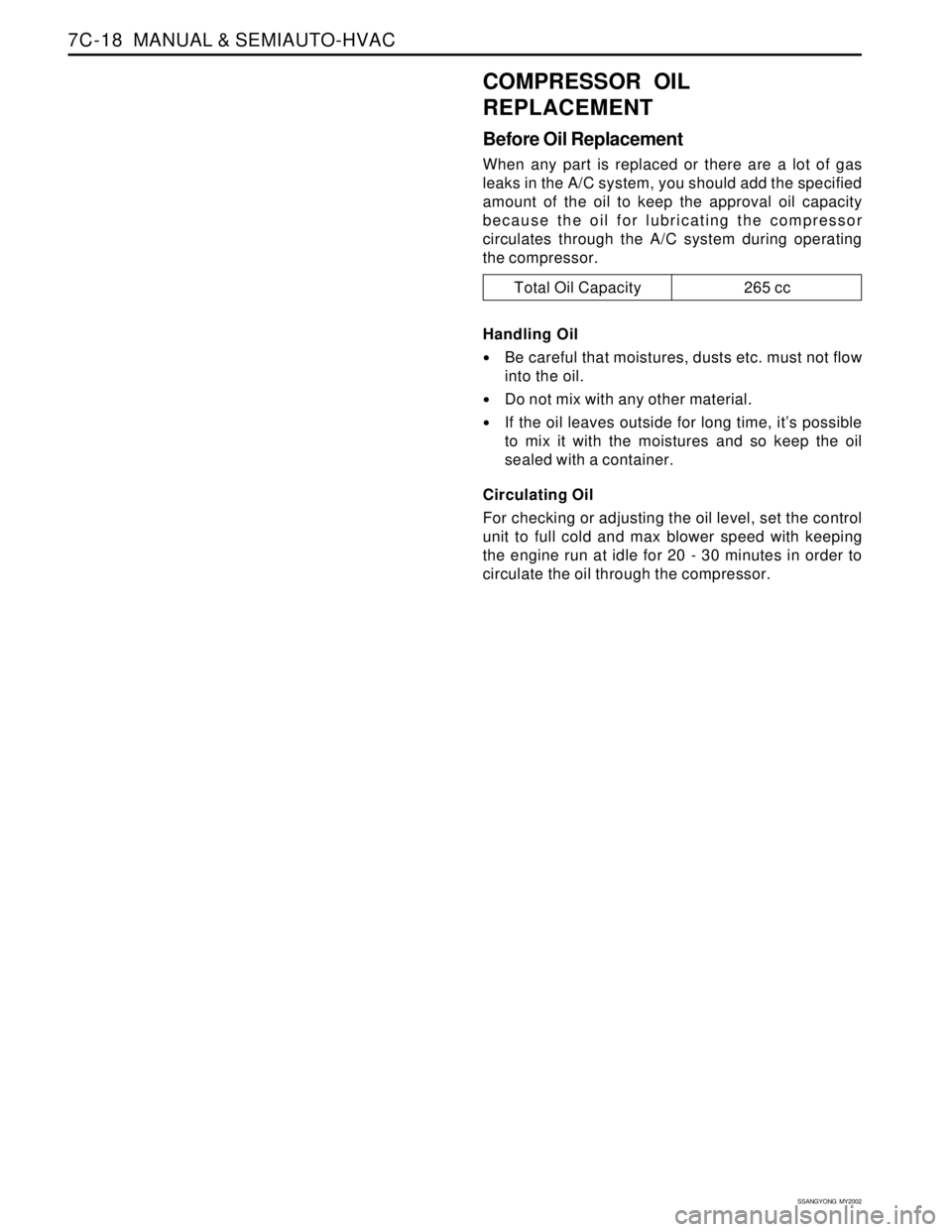
SSANGYONG MY2002
7C-18 MANUAL & SEMIAUTO-HVAC
Total Oil Capacity 265 cc
COMPRESSOR OIL
REPLACEMENT
Before Oil Replacement
When any part is replaced or there are a lot of gas
leaks in the A/C system, you should add the specified
amount of the oil to keep the approval oil capacity
because the oil for lubricating the compressor
circulates through the A/C system during operating
the compressor.
Handling Oil
Be careful that moistures, dusts etc. must not flow
into the oil.
Do not mix with any other material.
If the oil leaves outside for long time, it’s possible
to mix it with the moistures and so keep the oil
sealed with a container.
Circulating Oil
For checking or adjusting the oil level, set the control
unit to full cold and max blower speed with keeping
the engine run at idle for 20 - 30 minutes in order to
circulate the oil through the compressor.
Page 1573 of 2053
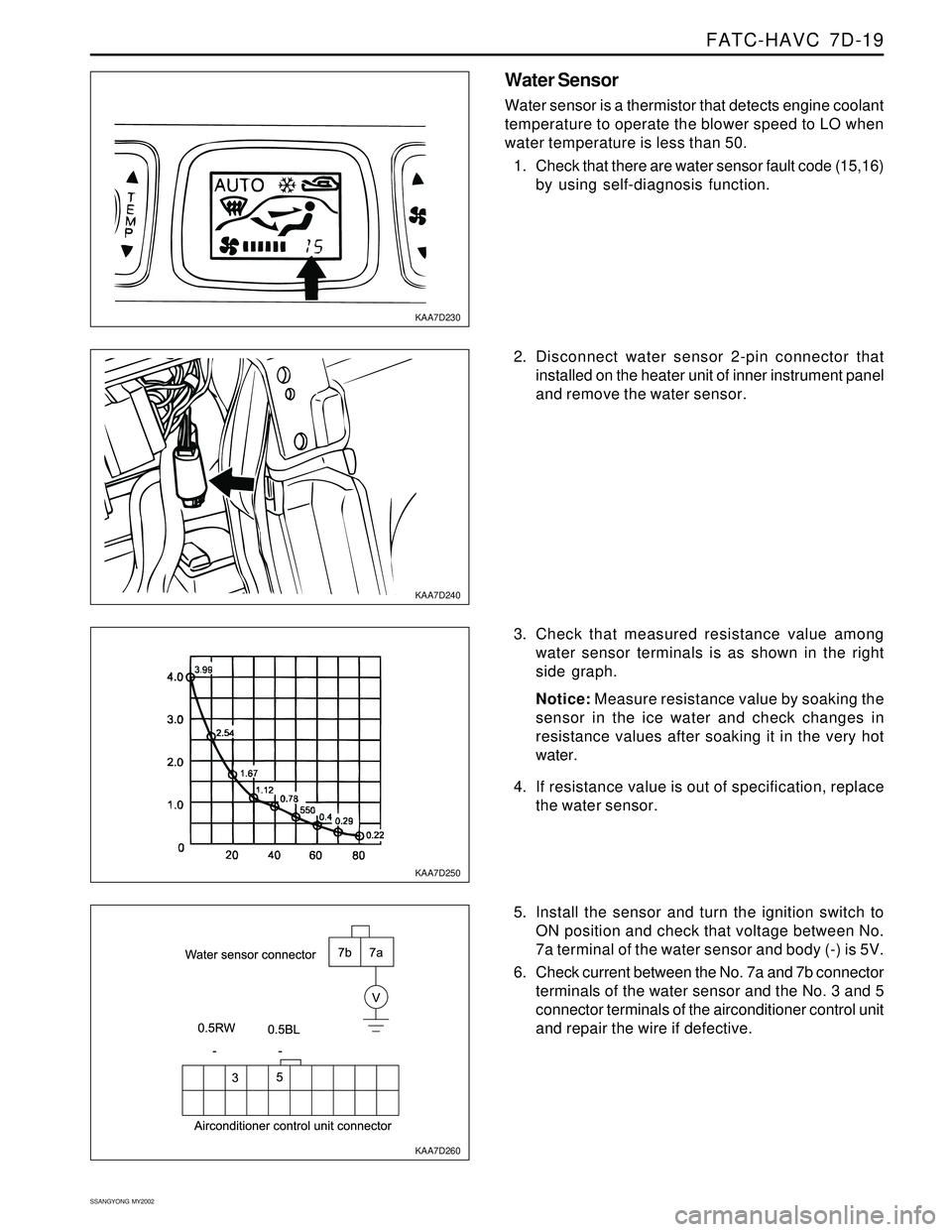
FATC-HAVC 7D-19
SSANGYONG MY2002
KAA7D230
KAA7D240
KAA7D250
KAA7D260
Water Sensor
Water sensor is a thermistor that detects engine coolant
temperature to operate the blower speed to LO when
water temperature is less than 50.
1. Check that there are water sensor fault code (15,16)
by using self-diagnosis function.
2. Disconnect water sensor 2-pin connector that
installed on the heater unit of inner instrument panel
and remove the water sensor.
3. Check that measured resistance value among
water sensor terminals is as shown in the right
side graph.
Notice: Measure resistance value by soaking the
sensor in the ice water and check changes in
resistance values after soaking it in the very hot
water.
4. If resistance value is out of specification, replace
the water sensor.
5. Install the sensor and turn the ignition switch to
ON position and check that voltage between No.
7a terminal of the water sensor and body (-) is 5V.
6. Check current between the No. 7a and 7b connector
terminals of the water sensor and the No. 3 and 5
connector terminals of the airconditioner control unit
and repair the wire if defective.
Page 1723 of 2053

SSANGYONG MY2002
9E-6 INSTRUMENTATION, DRIVER INFORMATION
Digital Clock Inoperative (Cont’d)
Step
1
2
3
4
5
6
7
8Action
Repair the open power supply circuit for the fuse.
Is the repair complete?
1. Turn the ignition ON.
2. Use a voltmeter to check the battery voltage
available at the clock connector terminal D1.
Does the voltmeter indicate the value specified?
Repair the open circuit between the clock connector
terminal D1 and the fuse F4.
Is the repair complete?
Turn the ignition ON.
Is battery voltage available at the clock connector
terminal C13?
Repair the open circuit between the clock connector
terminal C13 and the fuse F4.
Is the repair complete?
Check continuity between the clock connector
terminal C13 and ground.
Does the multimeter indicate the value specified?
Replace the clock.
Is the repair complete?
Repair the open ground circuit between the clock
connector terminal C13 and the ground G201.
Is the repair complete?Yes
System OK
Go to Step 7
System Ok
Go to Step 9
System OK
Go to Step 10
System OK
System OKNo
−
Go to Step 6
-
Go to Step 8
-
Go to Step 11
-
- Value(s)
−
11 - 14 v
-
-
-
0 Ω
-
-
SPEEDO METER
Speedometer Is Inoperative
Step
1
2
5
6
7
8Action
Check fuse F28, and F30.
Is fuse F28 and F30 blown?
1. Check for a short circuit and repair if necessary.
2. Replace the fuse F28, and F30.
Is the repair complete?
1. Turn the ignition ON.
2. Check the voltage at fuse F28 and F30.
Is the voltage equal to the specified value?
1. connect a scan tool.
2. Check for engine control diagnostic trouble codes
(DTCs).
Is a vehicle speed sensor DTC set?
1. Remove the instrument cluster.
2. Turn the ignition ON.
3. Check the voltage at instrument cluster connector
terminal A1.
Is the voltage equal to the specified value?
Repair the open circuit between fuse F30 and the
instrument cluster.
Is the repair complete?Yes
Go to Step 7
System OK
Go to Step 5
Go to Section
2F, Engine
Controls
Go to Step 8
System OKNo
Go to Step 3
-
Go to Step 4
Go to Step 6
Go to Step 7
- Value(s)
-
-
11 - 14 v
-
11 - 14 v
-
Page 1725 of 2053

SSANGYONG MY2002
9E-8 INSTRUMENTATION, DRIVER INFORMATION
TEMPERATURE GAUGE
Temperature Gauge Inoperative, Other Gauges OK
Step
1
2
3
4
5
6
7
8
9Action
Allow the engine to cool to room temperature.
With the ignition ON, does the temperature gauge
always read at the high end of the scale?
Disconnect the coolant temperature sensor electrical
connector.
Does the termperature gauge indicator drop to the
low end of the scale?
Replace the coolant temperature sensor.
Is the repair complete?
Check for a short to ground between the coolant
temperature sensor and the temperature gauge.
Is there a short to ground?
Repair the short to ground.
Is the repair complete?
Replace the temperature gauge.
Is the repair complete?
1. Disconnect the coolant temperature sensor.
2. Turn the ignition ON.
3. Check the voltage at the coolant temperature
sensor connector.
Does the the voltage equal the value specified?
Check for an open circuit between the coolant tem-
perature sensor and the temperature gauge.
Is the repair complete?
Repair the open circuit between the coolant tempera-
ture sensor and the temperature gauge.
Is the repair complete?Yes
Go to Step 7
Go to Step 3
System OK
Go to Step 5
System OK
System OK
Go to Step 10
Go to Step 8
System OKNo
Go to Step 2
Go to Step 4
-
Go to Step 6
-
-
Go to Step 8
Go to Step 6
- Value(s)
-
-
-
-
-
-
11 - 14 v
-
-
Fuel Gauge Inoperative (Cont’d)
Step
1
2
3Action
Check continuity between the fuel tank sending unit
connector C303 terminal 3, and groun.
Does the multimeter indicate the specified value?
Repair the open circuit or poor ground connection.
Is the repair complete?
1. With the fuel tank sending unit electrical connector
C303 disconnected, attach a jumper between
ground and C303 terminal 1.
2. Turn the ignition ON.
Does the fuel gauge move to full?Yes
Go to Step 11
System OK
Go to Step 3No
Go to Step 10
-
Go to Step 6 Value(s)
0 Ω
-
-